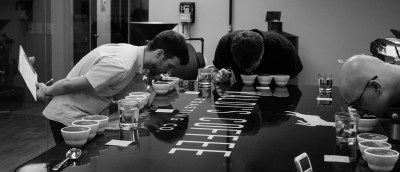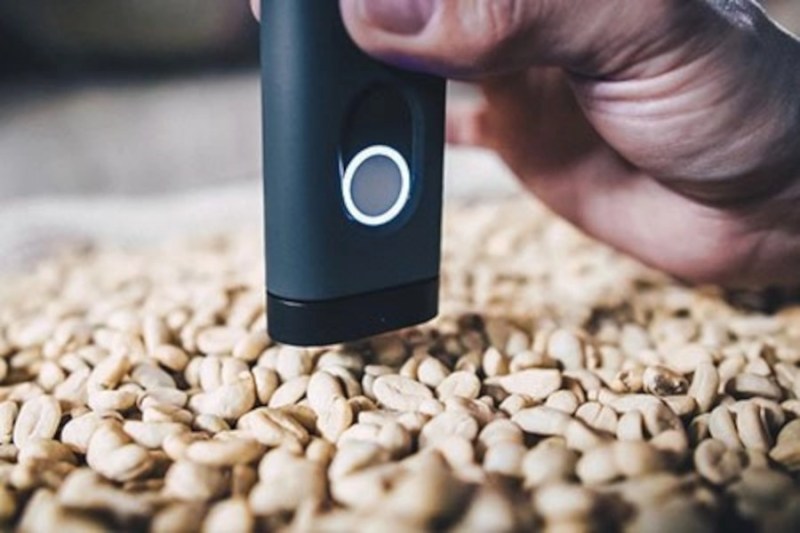If you’ve ever bought whole coffee beans, chances are good that there was all kinds of information on the bag that led to your decision, like the origin, the roast type, and the flavor notes. Traditionally, coffee grading — that’s judging the aroma of both dry and wet grounds and slurping the coffee evenly across the tongue to determine the flavor profile — is done by humans in a process called cupping. To call it a process is too clinical — it’s really more like a ceremony performed with the grave sincerity that coffee deserves.

There’s an industry standard coffee flavor wheel, so why not leverage that to make a robot that can remove the human bias and possible error of doing things the traditional way? That’s exactly what Demetria, a Columbian-Israeli company is doing.
They’ve developed an AI platform that can determine bean quality as judged by handheld scanners that were born on Kickstarter. The scanner uses near-infrared to look for biochemical markers in the bean, which it uses to match up with a profile backed by the all-knowing coffee flavor wheel.
Demetria is using SCiO scanners and a custom app to judge beans before they’re even roasted, which greatly speeds up the process but makes us wonder how green bean spectroscopy stacks up against roasted beans as judged by humans. You may remember the SCiO, a pocket-sized, connected spectrometer made by Consumer Physics that finally started delivering the goods a few years after funding. If you got your hands on a SCiO, you might like to know that there’s an open project out there to hack them. Sparkfun did a nice, thorough teardown, and it seems to be a well-engineered piece of hardware.
On the one hand, cupping is a tradition and thus may people feel that robbing coffee of this tradition will rob coffee of its soul. On the other hand, cupping is wasteful, as the coffee must be roasted and ground immediately prior to the ceremony and it requires the availability of Q graders who have been trained in the ways of coffee grading.
Want to know more about coffee production? Might as well learn the Retrotechtacular way.
[Main and thumbnail images via Demetria]
















Water is very important too.
Infact your life depends on water
You see without water I can’t make coffee
Without coffee…. well you can see where this is going…☕☕☕☕☕
I came back from Nicaragua once with a half kilo of fresh ground beans. It was just … beautiful.
I, too, enjoy packing my bags with several kilos of finest Columbian.
Colombian… what?
B^)
Nice, I recall when out attending one of the Eigenvector University’s, some group had an initiative to do similar to promote fair trade grading of the beans. This was back in the mid 2000’s if I’m recalling correctly. I’ll have to read into more.
I really doubt near infra red has the resolution to supply enough information, particularly in a hand held device to do any more than say it is looking at coffee, and even then it will have a hard time distinguishing it from let’s say burnt toast.
… what?
I have to agree, I’d have to see the chemometric model to even start to believe this.
Too much woo in food analysis, I’m afraid.
Didn’t we have a few of those magical failed portable spectroscopes that did nothing in real life? Like told us that they will be able to tell us the nutritional values of foods etc?
good mobile spectrometer and firmware open source sound great
not only for coffe, i need it for vegetables, cloth or trees too
Also, it is pretty disingenuous for SCiO to call their device a spectrometer with 12 sensors. Multiple spectrophotometers would be more appropriate. More advanced devices use a grating and a much denser array of detectors and even with the typically narrower range of wavelength scanned compared to a bench top instrument would have a higher chance of success. Even then it could likely only be used as a screening tool, and the sample would have to be prepared and read in an extremely consistent manner. If they were serious about this approach, there are much more accurate ways of getting a real spectrum.
spectrometer – noun
spec·trom·e·ter | \ spek-ˈträ-mə-tər
1 : an instrument used for measuring wavelengths of light spectra
You’re not very good at this, are you?
A couple years ago there was a scam Kickstarter with a similar goal/method that was supposed to tell you the basic nutrients in grocery store produce. While this sounds slightly more plausible, I highly doubt that it will ever work.
Yep, like I was assuming when last left off.
From my experience; you really need a CMOS, CCD, InGaAs or maybe a few other sensors will be suitable with ideally a FT design versus a Dispersive (diffraction grating) design for best performance.
MEMS and AOTF systems seem suitable also… though these way simpler designs most likely won’t have the resolution required.
Seems most cost effective to determine which webcam sensor extends into the NIR range?
The SCIO device seems for the price to be a great paradigm of thinking… though seriously doubting the capabilities with the limited resolution and sensor range that isn’t even disclosed. I vote fail for lack of clarity in regards to specs. and I hope that position isn’t a beta error.
I literally found there are 2K & 4K webcams on the market for under $30 that can make a decent webcam spectrometer with a diffraction grating, a double sided razor blade and whatever the user has to make a case.
Could it work? Sure. Would coffee snobs accept it? Never! Just replace coffee with wine and you can see why it could never fly.
Coffee snobs already accept the readings from an instrument to monitor roast temperatures and brewing water temperature, and an instrument to determine brew water pH, and another to weigh beans and water, and yet another device to time the brew cycle. Why would they reject the analysis of green beans if given by yet another instrument? It seems like they welcome as much quantitative data as they can get.
Now if they can only make a store-bought tomato that actually tastes good. That would be a real accomplishment.
There is such a thing, but it doesn’t survive shipping and transportation /storage